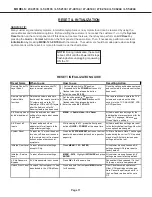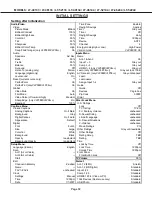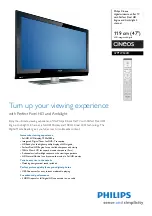
Page 6
MODELS: LT-40133 / LT-46133 / LT-52133 / LT-40134 / LT-46144 / LT-52144 / LT-46244 / LT-52244
Leakage current check
Before returning the receiver to the customer, it is recommended that leakage current be measured according to the
following methods.
1. Cold Check
With the alternating current (AC) plug removed from the AC source, place a jumper across the two AC plug
prongs. Connect one lead of an ohm meter to the AC plug and touch the other lead to each exposed metal part
(i.e. antennas, handle bracket, metal cabinet, screw heads, metal overlay, control shafts, etc.), particularly any
exposed metal part that has a return path to the chassis. The resistance of the exposed metal parts having a
return path to the chassis
should be a minimum of 1Meg Ohm
. Any resistance below this value indicates an
abnormal condition and requires corrective action.
2. Hot Check ...Use the circuit shown below to perform the hot check test.
1. Keep switch S1 open and connect the receiver to the measuring circuit. Immediately after
connection, and with the switching devices of the receiver in their operating positions, measure the
leakage current for both positions of switch S2.
2. Close switch S1, energizing the receiver. Immediately after closing switch S1, and with the
switching devices of the receiver in their operating positions, measure the leakage current for both
positions of switch S2. Repeat the current measurements of items 1 and 2 after the receiver has
reached thermal stabilization.
The leakage current must not exceed 0.5 milliampere (mA).
SAFETY PRECAUTIONS
NOTICE:
Observe all cautions and safety related notes located inside the receiver cabinet and on the receiver
chassis.
WARNING:
1.
Operation of this receiver outside the cabinet or with the cover removed presents a shock hazard from the
receiver's power supplies. Work on the receiver should not be attempted by anyone who is not thoroughly
familiar with the precautions necessary when working on high voltage equipment.
2.
Do not install, remove or handle the LCD panel in any manner unless shatterproof goggles are worn. People
not so equipped should be kept away while the panel is being handled. Keep the panel away from the body
while handling.
3.
When service is required, observe the original lead dress. Where a short-circuit has occurred, replace those
components that indicate evidence of overheating.
4.
If the LCD Panel is damaged, crystalline liquid may leak from the LCD panel and broken glass may be
scattered. The crystalline liquid is toxic. Avoid contact with your skin, eyes, or mouth. DO NOT touch the
broken glass or crystalline liquid with bare hands, as cuts, poisoning, and/or skin irritation may occur. DO
NOT let glass fragments or crystalline liquid get into your eyes or mouth. Should either contact your eyes or
mouth, rinse the contacted area thoroughly with water and consult your doctor.
5.
The fluorescent tubes in the panel contain mercury that is toxic and if broken should not be touched.
6.
DO NOT dispose of the TV with general household waste. Follow local laws and regulations for legal and
safe disposal of the TV. For disposal or recycling information, contact local authorities or the Electronic
Industries Alliance at www.eiae.org.





































